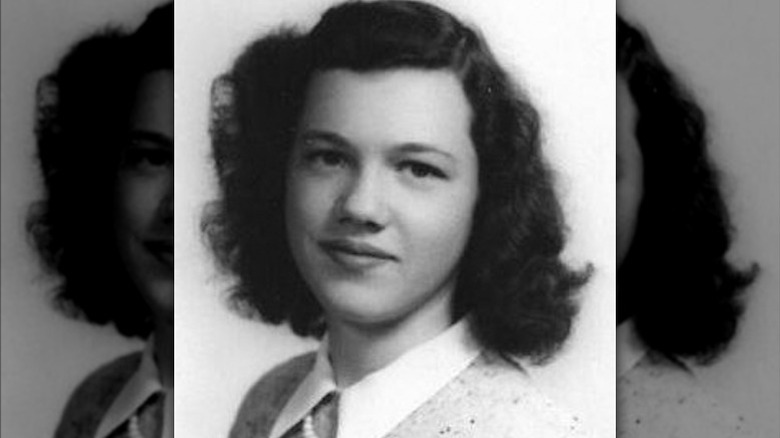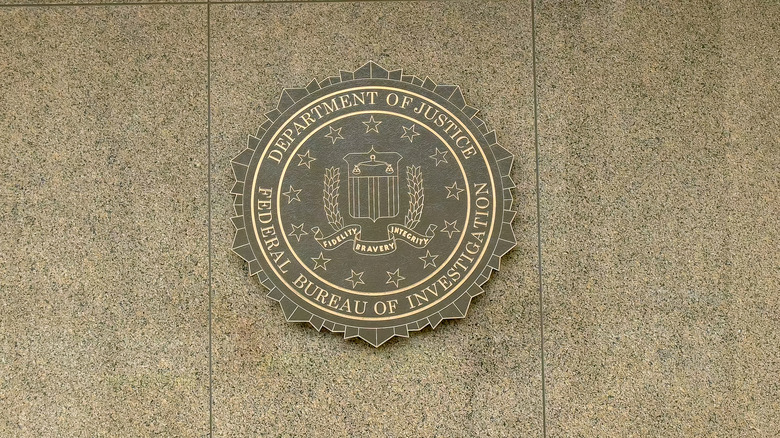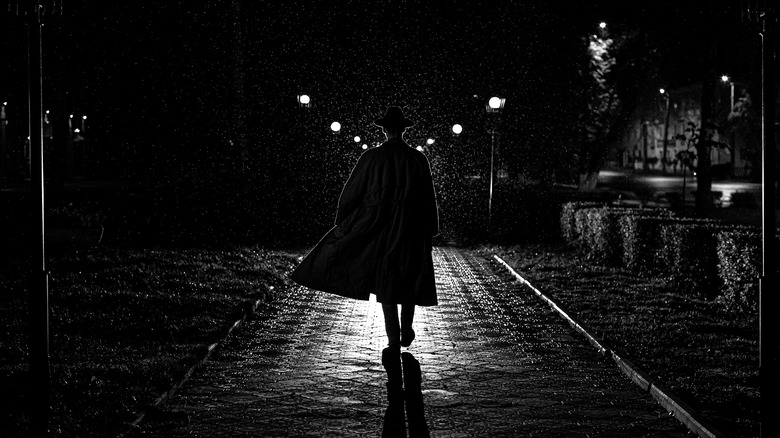The Tragic 1945 Disappearance And Presumed Murder Of Thora Chamberlain
Friday, November 2, 1945, was another beautiful fall day in Campbell, California, a suburb of San Jose. World War II had ended exactly a month earlier, and there were lots of soldiers and sailors around. Thora Chamberlain and some friends walked out of Campbell Union High School on their way to a football game. Thora, a sweet girl with blue eyes and brown hair, was just shy of 15, according to "The Murder of Thora Chamberlain: A Shocking True Crime Story." She was fashionable, from her blue sweater to her Bobby socks and penny loafers, per the Ventura County Star. She was also a little too trusting.
A man with dark, wavy hair wearing a U.S. Navy-style outfit drove up in a blue Plymouth sedan and asked her if she would babysit his sister's child, per "The Murder of Thora Chamberlain." It would be for no more than a half hour. Thora hesitated, then agreed when she saw the five-dollar bill in his hand. She got in. It was the last time anyone, except the man who had lured her into his car, would ever see her again.
Thora Chamberlain Goes Missing
When Thora Chamberlain failed to return home, her father, a well-respected San Jose contractor, became convinced someone had kidnapped her, according to the Visalia Times-Delta. After the local sheriff's department canvassed her classmates, they too came to believe she'd been abducted. Soon Sheriff William Emig asked other police agencies throughout California to aid in the search, per the Chicago Tribune.
One of the first clues of the case came when a local service station owner told authorities that a few weeks before Thora Chamberlain's kidnapping, her two young daughters had nearly been abducted in the same manner in nearby Belmont. But even with a description of the abductor and his vehicle, no other leads turned up. And when no ransom note arrived, authorities feared the worst, per the Spokane Chronicle. Meanwhile, the FBI reviewed the case to determine whether to take it since not all abductions fall under its jurisdiction.
The FBI Enters the fray
In mid-November, the FBI entered the Thora Chamberlain case and sent one of its very best, Special Agent in Charge Earl "E.J." Connelley, to investigate (per The Peninsula Times Tribune). Connelley, who headed up the bureau's "kidnap squad," had handled several high-profile cases, including the 1935 abduction of George Weyerhaeuser, the 9-year-old son of a Tacoma timber baron, per FBI Grapevine. He was also responsible for helping to bring down the infamous bank robber John Dillinger, per Bryan Burrough's 2009 book "Public Enemies: America's Greatest Crime Wave and the Birth of the FBI, 1933-34." Connelley was a World War I veteran with a pencil-thin mustache who'd been a G-Man since 1920, per "Public Enemies." According to FBI Grapevine, he was diminutive in stature but had a booming voice.
Through their investigation, Connelley and his agents honed in on a local truck driver as a suspect. His name was Thomas Henry McGonigle, who was married and in his early 30s, per the Santa Cruz Sentinel. When a San Francisco newspaper released his name, McGonigle fled to his father's house in Illinois. He had a long record that included an eight-year prison stretch in Illinois for attempted rape.
Bobby Socks, Confessions, and Recantations
The FBI tracked down Thomas McGonigle and brought him to San Francisco, where Thora Chamberlain's school friends — who'd been with her at the time of her abduction — picked him out of a lineup, according to "The Murder of Thora Chamberlain." The two girls McGonigle had failed to lure into his car also identified him, per the San Mateo Times. The FBI agents then began three days of interrogating McGonigle with no results. But on the fourth day, the suspect cracked and confessed to killing Thora Chamberlain. After Connelley asked him where the girl was, McGonigle, with a sickly smile, answered, "she's dead," per "The Murder of Thora Chamberlain."
But a confession without a body, especially at a time before DNA analysis and other forensic techniques, could be a hard sell to a jury. The FBI convinced McGonigle to take them to where he'd gotten rid of the body. High on a 350-foot cliff overlooking the Pacific Ocean called the Devil's Slide in San Mateo County, McGonigle pointed over the side where waves crashed and foamed and told the agents he'd hurled the body over the side, according to the Santa Cruz Sentinel. The authorities didn't find Thora Chamberlain's body, but they found her Bobby socks wedged into crevices halfway down the steep cliff, per the Santa Cruz Sentinel.
More Murders?
In the following months, Thomas McGonigle changed his story about what happened to Thora Chamberlain several times. Among the various versions of what he claimed happened, McGonigle said he accidentally shot and killed Chamberlain; stabbed her to death; or strangled her, per the Santa Cruz Sentinel. He later denied any knowledge of the crime.
He also told investigators he'd disposed of another body — Dorothy Ross Jones, a young Black waitress from San Francisco — at Devil's Slide. But, he claimed, it was an unnamed friend of his who'd killed Jones, and he was just helping to cover up the crime, per the Daily News. A beachcomber later discovered Jones' body near where McGonigle had thrown it into the sea. San Mateo prosecutors discussed the possibility of charging McGonigle with Jones' murder as well, but nothing came of it, per the Santa Cruz Sentinel. He eventually claimed to have killed 11 people, according to the newspaper.
Trial and Execution for Thora Chamberlain's Murder
Thomas McGonigle went to trial for the murder of Thora Chamberlain in February 1945 after pleading not guilty and not guilty by reason of insanity (per The Daily Pantagraph). His defense lawyers alleged at trial that the FBI had threatened McGonigle and coerced the confession. In the end, it was Thora Chamberlain's Bobby socks that did McGonigle in. The prosecutor, John McCarthy, heavily leaned on this piece of evidence during the trial, telling the jury that "in finding those socks, the crime was solved," per the Santa Cruz Sentinel. The jury agreed, taking only 38 minutes to convict McGonigle of first-degree murder and later finding him sane, per the newspaper. A judge sentenced him to die.
While McGonigle waited on death row, he continued to change his story and was allowed to leave San Quintin to help in the search for Chamberlain's body after claiming he'd buried it, per the United Press. On February 20, 1948, prison guards strapped McGonigle to a chair before dropping cyanide into a bucket at his feet, per United Press. He gasped three times and was dead. In a strange twist, he donated his body to science, specifically to a Berkley scientist working on resurrecting the dead, per the Associated Press. His victim's body was never found. While the Thora Chamberlain case isn't necessarily an unsolved disappearance, her family never received the solace that could come from knowing exactly what happened to their loved one or from getting to bury her in hallowed ground.





